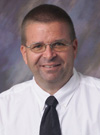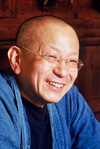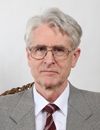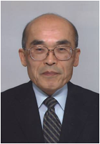Invited Speakers
 |
Clark CORY
|
| Title | |
| BIM and its impact on Engineering & Graphic Communication Education | |
| Abstract | |
| The construction industry is being inundated with new technology utilized to help expedite all processes of construction. Visualization of the entire process and individual assemblies of materials has become a standard requirement for individuals in the construction industry. The traditional means of education needed for construction was gathered by hands on experience and could take several years for the individual to obtain. Today's engineer or construction manager that goes through a higher educational system has the ability to utilize new technologies enabling her/him to obtain the visualization education quicker than traditional means. Technology is providing marketing alternatives such as three-dimensional models for visualization, simulation and spatial analysis. Building Information Modeling (BIM) was is a process or a way of life for construction companies. The building information model is currently used from inception through design into construction and even into facility management. Not only is education and industry changing to meet current technological changes, but the clients proposing those structures are changing the type of information required from companies to build their projects. The traditional method of construction graphic education has to change, evolve and adapt to current spatial visualization & BIM construction standards. | |
| Biography | |
| Clark Cory joined the Computer Graphic Technology Department at Purdue University in 1999. Clark's primary professional responsibility is undergraduate instruction in architectural and construction graphic communication and visualization. He currently continues to develop & improve the Construction Graphics Communication specialty area within the Computer Graphics Department at Purdue. Clark has had over 35 years experience in the AEC industry with positions ranging from general laborer to project manager of residential & commercial structures and even designer. In addition to professional experience, teaching, and student organizations participation; Clark is currently involved in industry/educational partnerships with such companies as Holder Construction, Saterfield & Pontikes as well as software developers like AutoCAD & Argos Systems Inc. that develop and promote construction visualization, Building Information Modeling, 4D CAD, 5D CAD, animation for AEC, AEC illustration, smart house technology, and visual communication information which his primary areas of research. | |
|
|
|
 |
Hans-Peter SCHROECKER |
| Title | |
| Discrete Gliding Along Principal Curves | |
| Abstract | |
| Discrete differential geometry is a highly active field of geometrical research. Its aim is the development of discrete notions for well-known concepts from differential geometry. The resulting theories are often more elementary and concrete when compared to their smooth counterparts. While classic differential geometry is largely based on analysis, elementary geometric incidence or closure theorems are at the core of discrete differential geometry. It naturally lends itself to applications that require numeric simulation, visualization, or the building of real world objects. In our talk we relate recent results in discrete differential geometry to spatial kinematics. We study a special type of discrete spatial motions which we call rotational. Important examples are gliding motions along principally parametrized surfaces. Rather unexpectedly, discrete rotational motions of this type satisfy a fundamental multidimensional consistency criterion and are related to classical surface transformations. Apart from the mere presentation of these results we want to demonstrate how geometric constructions in the discrete setting replace the differential calculus of the smooth case. This observation opens a new view on well-established mathematical theories and their relations to geometry. |
|
| Biography | |
| Hans-Peter SCHROECKER studied Mathematics and Descriptive Geometry at the Karl-Franzens University Graz and the Graz University of Technology. After positions at the University of Applied Arts in Vienna and the Vienna University of Technology he joined the Unit Geometry and CAD at the University of Innsbruck (Austria) in 2004. From July to September 2006 he spent a research stay at the Department of Computer and Graphic Science, College of Arts and Sciences, The University of Tokyo. His research interest include classical geometry and its applications, kinematic geometry, didactics of geometry and, more recently, convex and discrete geometry. | |
|
|
|
 |
Satoshi YABUUCHI |
| Title | |
| An Introduction of the Use of 3D Digital Data of Cultural Properties (Sculpture) in Education and Research - An Example of its Use in Cultural Property Preservation at Tokyo University of the Arts - |
|
| Abstract | |
| In our laboratory, we use 3D laser scanning to collect 3D digital data of sculptures that are recognized as cultural properties (mainly wooden Buddhist statuary) and utilize this for educational research. It is used by students studying on master and doctorate courses when reproducing classic sculptures employing the same materials and techniques as the original. This allows them to efficiently achieve a mastery of classical techniques while allowing them to develop the outlook, skills and sensitivity required of people who work in the field of cultural properties preservation and restoration. Furthermore, it allows us to rediscover lost techniques and forms to pass on to the future, while hopeful hopefully stimulating contemporary artists, and providing a source of inspiration for new creativity. Finally, this data also contributes to the understanding of art history, promoting studies into the characteristics of the work and the artists of the past. | |
| Biography | |
| Born in Osaka, Japan, in 1953, YABUUCHI Satoshi studied sculpture at Tokyo University of the Arts to postgraduate level. From 1982 to 1987 he participated in the research and preservation of ancient wooden Buddhist sculpture at the university's Conservation and Restoration Laboratory for Cultural Properties. From this experience he developed his own unique sculpting technique, based on traditional methods, and is currently active in a wide range of fields including wood and bronze sculpture, woodblock prints and writing. | |
|
|
|
 |
Tibor TARNAI
|
| Title | |
| Turned Ivory Polyhedra | |
| Abstract | |
| Nowadays souvenir shops in China sell "devil's work balls" or "puzzle balls", that is, multiple spherical nested shells made of jade, sandalwood or artificial ivory. During the Qing Dynasty, such balls turned on a lathe were made of ivory with piercing and rich figurative carving. The manufacturing technology requires radially drilled conical holes whose number is usually 12 or 14, and they are arranged with icosahedral or octahedral symmetry. Similar ivory art objects appeared in Europe in the second half of the 16th century. Their manufacturing method was developed in Germany. The art of turning ivory was prosperous until the 18th century when with the appearance of porcelain this art ceased to exist. Contrary to the Chinese balls, the European balls have a smooth surface and a polyhedron-like shape. The polyhedral form shows a high level of geometrical knowledge of the artists, and this is also why the number of applied holes is not only 12 or 14, but many more (e.g. 6, 20, 24, 26, 32). In this paper, we want to present a geometrical survey of nested ivory spheres and polyhedra, and to show examples of related objects of famous ivory collections (e.g. in Dresden, Vienna, Copenhagen, Florence). | |
| Biography | |
| Tibor TARNAI graduated in civil engineering at the Technical University of Budapest in 1966, and in applied mathematics at the E?tv?s University of Budapest in 1973. He worked as a structural engineer at different building design firms and as a structural researcher at the Hungarian Institute for Building Science until 1993 when he became Professor of Structural Mechanics at the Budapest University of Technology and Economics. He was visiting researcher at several universities including Cambridge and Oxford as well as the University of Tokyo and the Kyoto University. Over the past thirty years his research has focused on structural topology, a discipline at the boundary of mechanics and mathematics. He has a particular interest in mobile structures such as deployable structures and in packing and covering problems of discrete geometry. His research interest also includes applied geometry and polyhedra. | |
|
|
|
 |
Toshio YAMASHITA
|
| Title | |
| Research of Digital Lead Design Process | |
| Abstract | |
| In recent years, due to the utilization of CAD, in the field of automobile development, a drastic change has taken place in reducing R&D period and improving product quality. However, this utilization excluded the computerization of the upstream phase in design development process. This time, I will describe the new design development process implemented at Nissan Motor Co., Ltd. with the actual outputs and issues of the projects that they utilized it in the early phase of the development. The company developed the new process by making improvements in reducing required development period and costs, and furthermore by working on the improvement of merchantability from the perspective of design in the phase of design idea / concept generation, which is the hardest phase to be computerized in design development process. In addition, I will introduce the trends by industry to look for a future image of design development process. | |
| Biography | |
| Toshio Yamashita joined the faculty of Tokyo Metropolitan University in 2008. His teaching specialty is Transportation design and his research interest is "Utilization of digital tools for automotive styling development" and "Design (Styling) contribution and approach to environmental issues." Prior to this position, he engaged in Automobile Design (Styling) as designer and delivered frontline performances at Nissan Motor Co. Ltd. One of his representative works is Fairlady Z32 (300ZX). He directed Titan series as the chief designer at Nissan Design America from 2000 to 2003. |
|
|
|
|
| Welcome Lecture Speakers | |
 |
Koji MIYAZAKI |
| Title | |
| An Adventure in Four-dimensional Space and Time | |
| Abstract | |
| There are two themes in this lecture. One is for a panorama of 4-dimensional geometric shapes used in the future art and science and the other for a sight-seeing of traditional geometric shapes looked in the past of Japan. These contents may be unified as the 4-dimensional space-time continuum. First, various projections into 3-dimensional space of a 4-dimensional polyhedron, a polytope, and a 4-dimensional curved hypersurface are shown as putting regular polytopes and quadratic hypersurfaces in the main. Their curious and interesting features are useful for imaging the shapes of virtual objects which may appear in 4-dimensional art and science in the future. Next, various geometric shapes seen in the past of Japan are shown to have a new opinion of Japanese traditional beauty. They may give some hints for newly understanding of the Japanese culture. Go to the future and back to the past through this lecture. | |
| Biography | |
|
Born in Tokushima-city (1940) EDUCATION 1959-1963 Kyoto Institute of Technology, Faculty of Architectural Design ACADEMIC APPOINTMENTS Research Associate, Faculty of Engineering, Kansai University, Associate Professor, Department of Liberal Arts, Kobe University, Professor, Graduate School of Human and Environmental Studies, Kyoto University, Professor emeritus, Kyoto University AREAS OF RESEARCH Architectural Morphology, Higher-Dimensional Graphics |
|